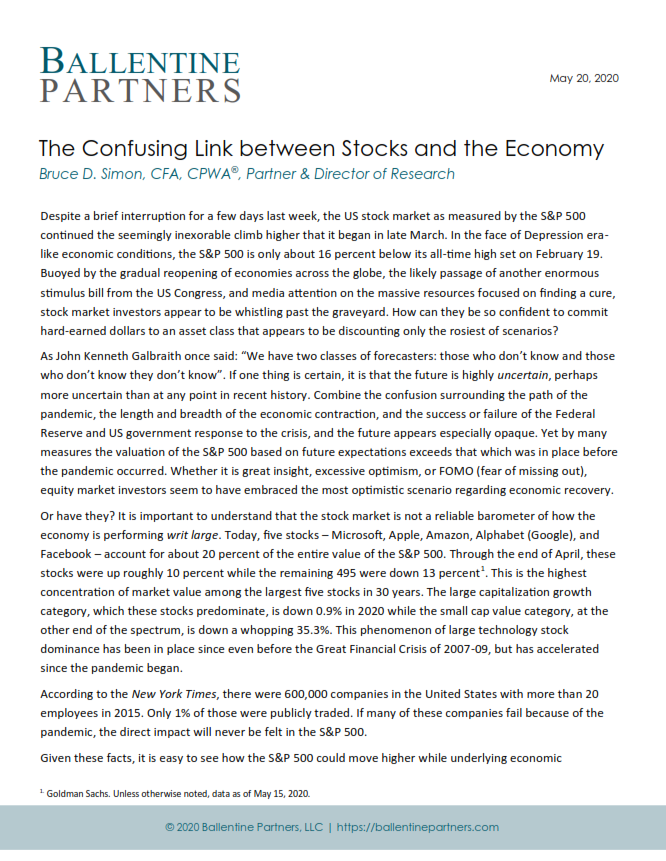Despite a brief interruption for a few days last week, the US stock market as measured by the S&P 500 continued the seemingly inexorable climb higher that it began in late March. In the face of Depression era-like economic conditions, the S&P 500 is only about 16 percent below its all-time high set on February 19. Buoyed by the gradual reopening of economies across the globe, the likely passage of another enormous stimulus bill from the US Congress, and media attention on the massive resources focused on finding a cure, stock market investors appear to be whistling past the graveyard. How can they be so confident to commit hard-earned dollars to an asset class that appears to be discounting only the rosiest of scenarios?
As John Kenneth Galbraith once said: “We have two classes of forecasters: those who don’t know and those who don’t know they don’t know”. If one thing is certain, it is that the future is highly uncertain, perhaps more uncertain than at any point in recent history. Combine the confusion surrounding the path of the pandemic, the length and breadth of the economic contraction, and the success or failure of the Federal Reserve and US government response to the crisis, and the future appears especially opaque. Yet by many measures the valuation of the S&P 500 based on future expectations exceeds that which was in place before the pandemic occurred. Whether it is great insight, excessive optimism, or FOMO (fear of missing out), equity market investors seem to have embraced the most optimistic scenario regarding economic recovery.
Or have they? It is important to understand that the stock market is not a reliable barometer of how the economy is performing writ large. Today, five stocks – Microsoft, Apple, Amazon, Alphabet (Google), and Facebook – account for about 20 percent of the entire value of the S&P 500. Through the end of April, these stocks were up roughly 10 percent while the remaining 495 were down 13 percent1. This is the highest concentration of market value among the largest five stocks in 30 years. The large capitalization growth category, which these stocks predominate, is down 0.9% in 2020 while the small cap value category, at the other end of the spectrum, is down a whopping 35.3%. This phenomenon of large technology stock dominance has been in place since even before the Great Financial Crisis of 2007-09, but has accelerated since the pandemic began.
According to the New York Times, there were 600,000 companies in the United States with more than 20 employees in 2015. Only 1% of those were publicly traded. If many of these companies fail because of the pandemic, the direct impact will never be felt in the S&P 500.
Given these facts, it is easy to see how the S&P 500 could move higher while underlying economic fundamentals continue to deteriorate. Perhaps investors are simply placing their bets on the companies likely to thrive in the post-pandemic world, rather than embracing the bullish economic recovery story. Nonetheless, it seems likely that at some point in the future these trends must converge. It is hard to envision even the Big 5 growing at past historical rates when the consumers of their products and services are struggling to survive.
While the S&P 500 appears fully valued as a result of its dependence on the Big 5, the number of smaller companies in weakened financial condition should create attractive opportunities for investors, especially those that have access to the private markets. In that regard, we are currently evaluating a short list of distressed credit managers with a history of success during prior periods of extreme economic weakness.
We acknowledge the possibility that the bulls might be right and the current uncertainty will be resolved favorably, leading to even higher stock prices. We also recognize that optimistic views are nothing more than (semi)-educated guesses, in that no one has encountered the confluence of events we are now facing.
Active managers that have failed to make meaningful bets on this small group of winning stocks will find themselves substantially lagging their benchmarks. As proponents of indexing, our approach allows us to participate in the strong performance of the Big 5 while also maintaining considerable exposure to the laggards should the momentum reverse.
As legendary investor Peter Bernstein once quipped, “Forecasts create the mirage that the future is knowable”.
Learn more about Bruce Simon, our Director of Research.
This report is the confidential work product of Ballentine Partners. Unauthorized distribution of this material is strictly prohibited. The information in this report is deemed to be reliable but has not been independently verified. Some of the conclusions in this report are intended to be generalizations. The specific circumstances of an individual’s situation may require advice that is different from that reflected in this report. Furthermore, the advice reflected in this report is based on our opinion, and our opinion may change as new information becomes available. Nothing in this presentation should be construed as an offer to sell or a solicitation of an offer to buy any securities. You should read the prospectus or offering memo before making any investment. You are solely responsible for any decision to invest in a private offering. The investment recommendations contained in this document may not prove to be profitable, and the actual performance of any investment may not be as favorable as the expectations that are expressed in this document. There is no guarantee that the past performance of any investment will continue in the future.




